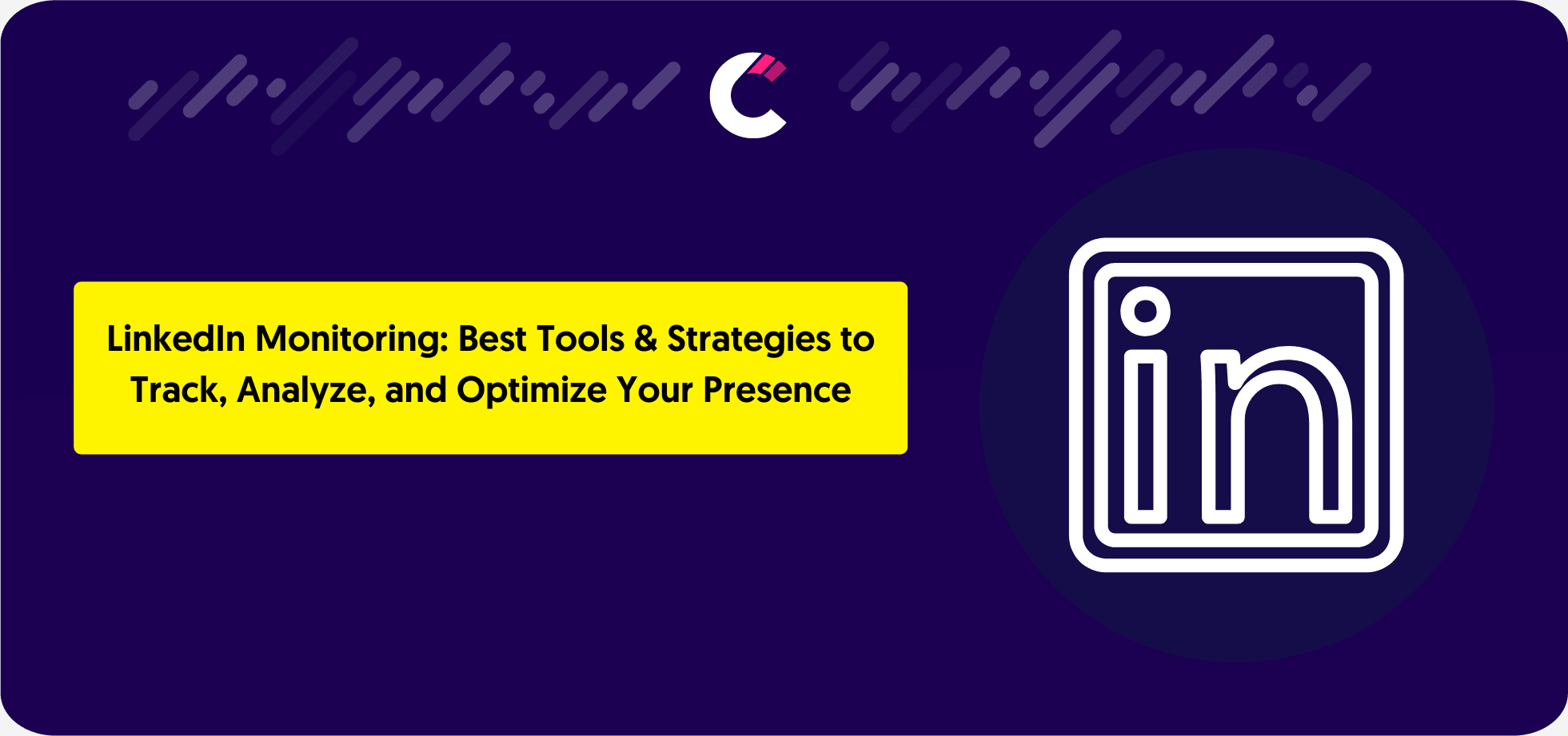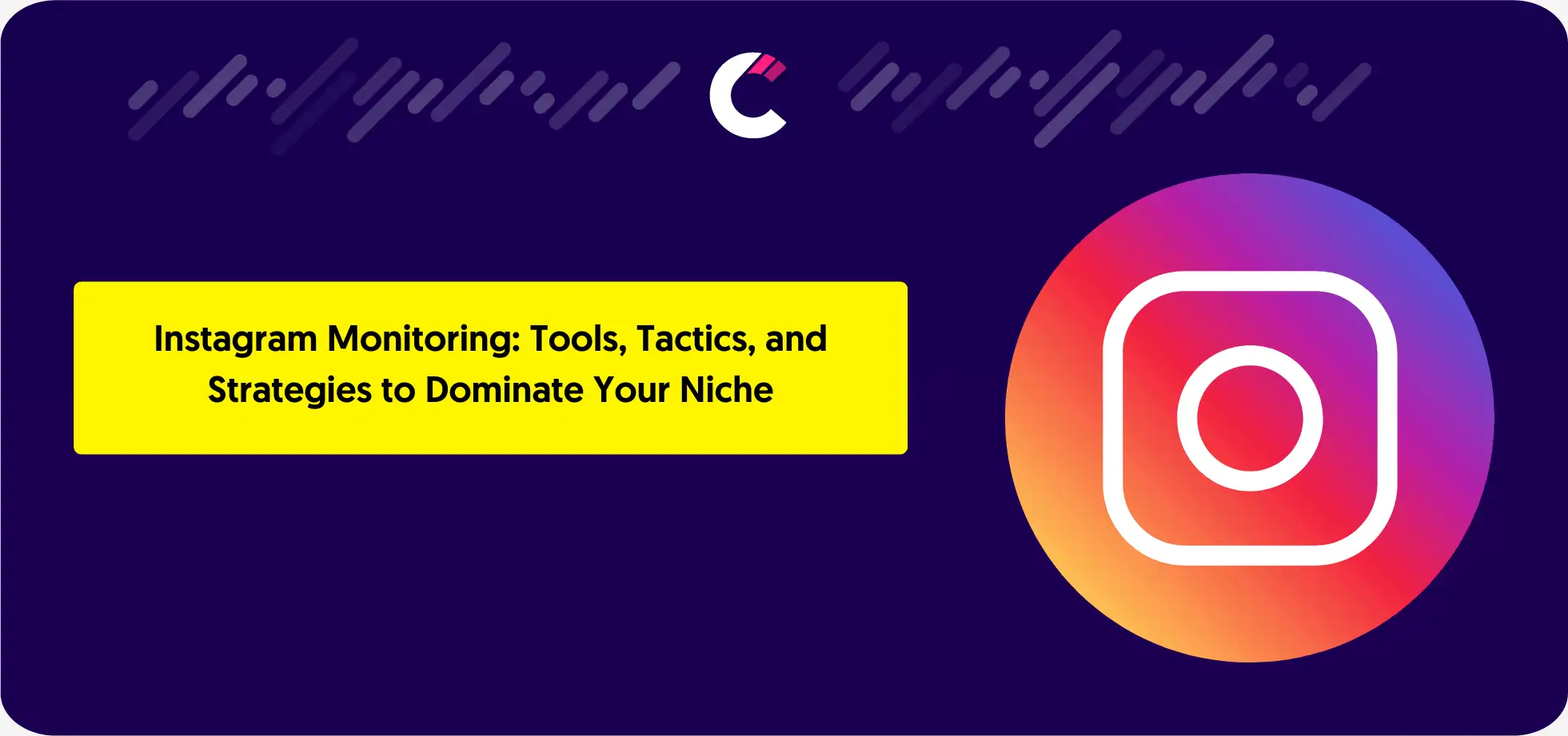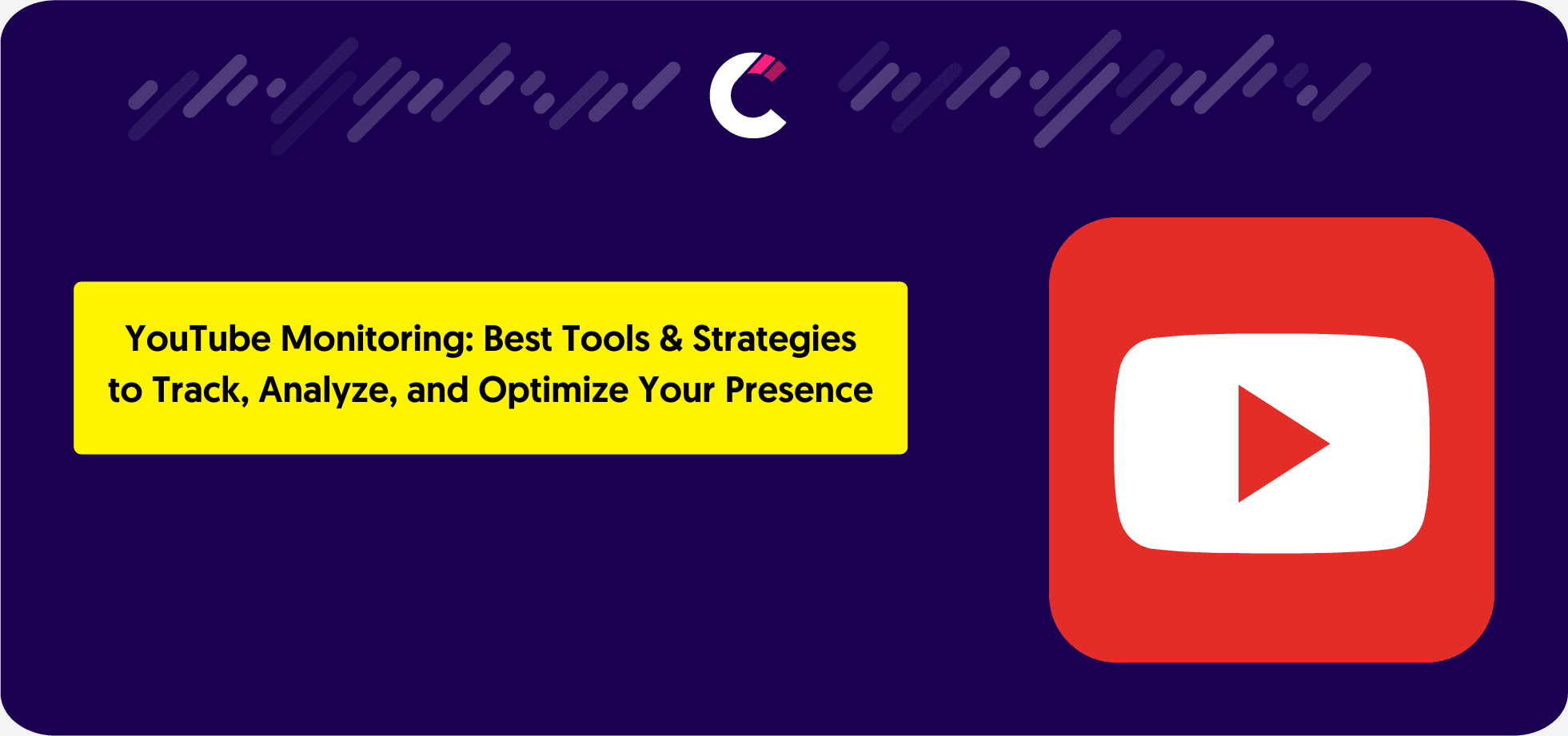What is Social Business Intelligence?
So, what exactly is social business intelligence (SBI)? In simple terms, it’s the process of gathering and analyzing data from social media and other online platforms to inform business decisions.
Think of it like a supercharged version of traditional business intelligence, but with a focus on the conversations and behaviors happening in real time. Unlike traditional BI, which typically relies on internal company data, SBI pulls insights from external sources like Twitter, Facebook, blogs, and online reviews.
That means businesses can understand not just how well they’re doing internally, but also how they’re perceived in the market, what their customers care about, and what their competitors are up to. It’s essentially a 24/7 feedback loop.
How Social Business Intelligence Differs from Traditional Business Intelligence
At first glance, social business intelligence might seem like just another form of traditional business intelligence. However, they serve different purposes and use distinct methods:
Traditional Business Intelligence (BI):
- Relies on structured data, such as:
- Sales numbers
- Website traffic
- Inventory reports
- Primarily focuses on internal company metrics to evaluate performance.
- While it’s critical for understanding a business’s internal health, it doesn’t capture the external shifts in the market.
- Relies on structured data, such as:
Social Business Intelligence (SBI):
- Taps into unstructured data, which includes:
- Social media conversations
- Online reviews
- Customer sentiments and feedback
- Provides insights into what people are saying online, their emotions, and the trends emerging in real time.
- Delivers a 360-degree view of both the company’s performance and how it’s perceived externally, offering insights into customers’ wants, needs, and overall market sentiment.
- It’s a more holistic approach, incorporating not just internal company data, but also what’s happening in the broader market and within consumer conversations.
- Taps into unstructured data, which includes:
Components of Social Business Intelligence

When you start exploring social business intelligence, it’s easy to feel overwhelmed by the amount of data available.
From my experience, though, once you break it down into key components, it all starts to make sense. Mastering these areas has been essential for getting the most value from SBI. Let’s go over the main components.
Data Collection
The first step in building an effective SBI strategy is data collection. One thing I’ve learned in my time working with clients is that accurate and timely data collection is crucial. It’s not just about grabbing data from social media platforms; it’s about choosing the right sources.
For example, pulling data from Twitter about your competitors can reveal more than just how often they tweet. It can show you how engaged their audience is, the sentiment around new product launches, and how they compare to your brand. I’ve found that using both automated tools and manual monitoring works best to ensure the data is both accurate and comprehensive.
Whether you’re using social listening tools or scraping data from online forums, collecting the right insights is a critical first step in SBI.
Data Integration
Next up is integration. You could have all the social data in the world, but if it’s not connected to your business intelligence systems, it won’t do much. I’ve seen companies struggle with this—having multiple data streams that don’t interact with each other.
From experience, I can tell you that seamless integration between social media insights and traditional business data is vital. When you integrate your social data with CRM platforms or analytics dashboards, you get a complete picture of both customer behavior and business performance. This makes it easier to track how social media impacts things like sales, customer loyalty, and churn.
Data Analysis and Visualization
Once you’ve collected and integrated your data, the next step is analysis and visualization. I’ve worked with teams who had all the data but struggled to understand what it meant. Raw data and social media mentions are helpful, but without analysis, they’re not actionable.
Tools like Google Analytics, Power BI, or Tableau make it easier to turn that data into something meaningful. These tools help you visualize key performance indicators (KPIs), such as sentiment analysis, engagement metrics, and share of voice. For example, you might track mentions of your brand on Twitter and see a sharp increase in activity after a product launch. With the right visualization, you can directly correlate that spike to increased sales or website traffic, showing the success of the campaign.
Reporting and Monitoring
Finally, reporting and monitoring. If you’re not measuring the impact of your social insights, you won’t know how effective they are. I’ve helped clients set up dashboards that track performance metrics in real time, so they don’t have to wait for a monthly report to understand how things are going.
Real-time monitoring allows businesses to spot issues and opportunities quickly.
For example, if you notice a sudden rise in negative sentiment about your brand, you can address it immediately. I’ve worked on systems that alert you when customer feedback drops below a certain threshold, which ensures you can act fast. It’s about staying ahead of the game and making sure you’re not caught off guard by emerging trends or problems.
The Role of Social Intelligence in Business
Social intelligence is essential for businesses looking to remain competitive and agile in today’s fast-paced world. It’s not just about gathering data from social media platforms; it’s about transforming that data into valuable insights that guide decisions and strategies. From my experience, businesses that leverage social intelligence effectively often find themselves better positioned to engage customers, spot trends, and make faster, smarter decisions.
Benefits of Social Business Intelligence
Social business intelligence comes with several key benefits that help businesses stay ahead of the curve:
Improved Customer Engagement:
Social business intelligence allows businesses to understand their customers’ sentiments and behaviors on a deeper level. By monitoring social media conversations, brands can engage with customers in real-time and respond quickly to feedback. In one project I worked on, we saw that customer satisfaction soared after we started responding to social media comments more quickly. It’s about showing customers that they’re heard and valued, which ultimately leads to stronger loyalty.Early Trend Detection:
One of the biggest advantages of social intelligence is its ability to track emerging trends. Traditional market research can take months, but social media offers real-time insights. From my own experience, I’ve seen how social media listening helps businesses anticipate shifts in consumer behavior before they become widespread. For instance, a brand I helped monitor saw an uptick in interest around eco-friendly products, which allowed them to launch a targeted campaign just as the trend was taking off, resulting in increased sales.Informed Decision-Making:
Social data provides businesses with real-time insights, enabling faster decision-making. I’ve seen companies adjust their marketing strategies mid-campaign based on social media feedback. By integrating social intelligence into decision-making, businesses can pivot quickly, whether it’s shifting their messaging or refining their product features based on customer responses.
Unlocking Business Insights from Social Media Data
Social media data holds immense potential, but the real value comes from knowing how to extract meaningful insights:
Understanding Customer Behavior and Preferences:
Social business intelligence gives businesses a better understanding of what their customers want, what excites them, and where there may be pain points. In a recent case, we used social listening to identify a feature that customers were consistently praising about a product, which led to a decision to double down on marketing that specific feature. By analyzing social data, businesses can align their offerings with customer needs.Spotting Areas for Improvement:
One thing I’ve learned over the years is that social listening can help businesses spot problems early. For example, I worked with a company that was receiving negative feedback about their customer service through social channels. Instead of letting those issues snowball, we were able to take swift action—addressing the feedback publicly and internally improving service protocols. This proactive approach helped retain customers and even turned the situation into a positive one, showcasing the company’s commitment to customer satisfaction.
Driving Business Growth through Social Insights
Social intelligence doesn’t just help businesses stay on track; it’s also a key driver of growth:
Innovation and Product Development:
Social media conversations often highlight unmet needs in the market, and by paying attention, businesses can uncover new opportunities. I’ve worked with teams that used social insights to develop new product features or services that customers didn’t even realize they wanted until they saw the conversation unfolding online. This proactive approach to product development has led to increased demand and customer loyalty.Optimizing Marketing and Sales:
Using social intelligence, businesses can refine their marketing strategies to better resonate with their audience. By analyzing trends and conversations, brands can create more targeted campaigns. In one of my experiences, a company saw a significant increase in conversion rates after adjusting their ads based on insights gained from social listening.Customer Acquisition and Retention:
Social intelligence not only helps with acquiring new customers but also plays a key role in retaining existing ones. By responding to social media conversations and feedback, businesses show they are actively listening. This level of engagement creates a more loyal customer base. I’ve personally seen how businesses that use social intelligence to manage customer relationships are far more likely to build long-term, loyal customers.
How Social Business Intelligence Benefits Your Marketing Strategy
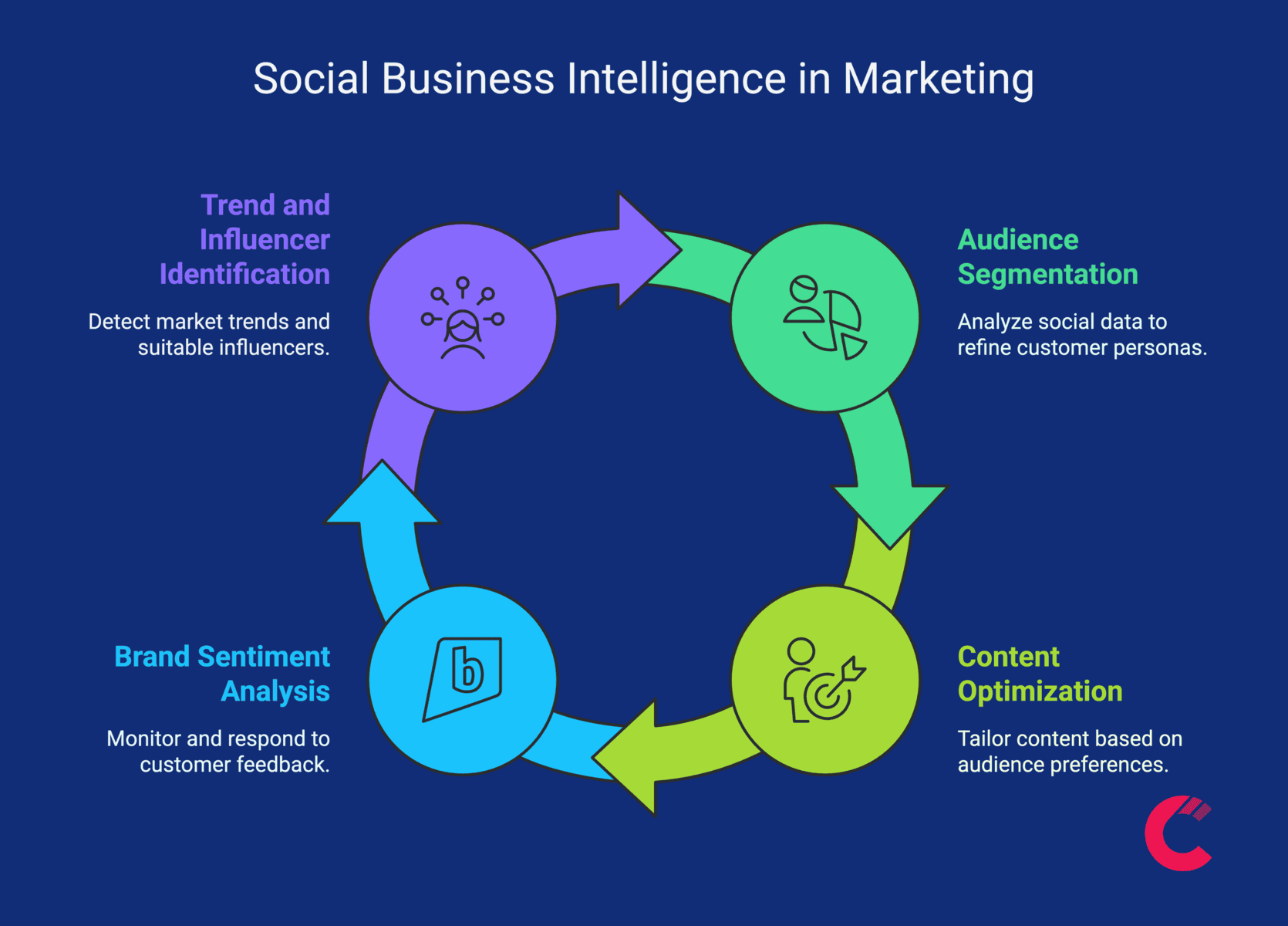
Social business intelligence has dramatically changed how marketers approach their strategies. It moves marketing from guesswork to informed decision-making, helping businesses understand their audience, optimize content, and fine-tune their campaigns.
Here’s how it can make a significant impact:
Audience Segmentation and Targeting
From my experience, one of the biggest benefits of social business intelligence is how it enhances audience segmentation. By analyzing social data, you can uncover detailed insights into customer interests, behaviors, and demographics. I’ve worked with brands that used this data to refine their customer personas, which helped them create marketing campaigns that spoke directly to the needs of their audience.
Social media platforms provide a wealth of information about customer preferences. By examining who engages with your content and tracking their interactions, businesses can identify high-value segments, making it easier to target the right people and improve campaign effectiveness.
Content Optimization
When it comes to content creation, social business intelligence provides crucial data on what works and what doesn’t. I’ve seen teams use social listening tools to track which types of posts perform best, whether it’s blog articles, videos, or even polls. This information helps brands tailor their content to match what resonates with their audience.
Moreover, social insights can guide the tone, style, and format of future content. By tracking trending topics and key phrases used by your audience, businesses can align their messaging to be more relevant, making it easier to capture their attention and keep them engaged.
Brand Sentiment and Customer Feedback
Social listening helps you understand not just what people are saying, but how they feel about your brand. Tracking sentiment across platforms provides businesses with valuable insights into how their products or services are perceived. By monitoring this feedback, brands can address concerns or celebrate successes in real time.
It’s also a great way to evaluate marketing campaigns. A sudden shift in sentiment can tell you if your campaign is working or if adjustments are needed. Real-time tracking allows businesses to respond quickly, ensuring they stay on top of customer opinions and remain proactive.
Identifying Trends and Influencers
Beyond customer feedback, social business intelligence can uncover valuable market trends. By analyzing social media conversations, businesses can identify new topics of interest or upcoming shifts in the industry. This enables them to adapt their strategies ahead of the competition.
Additionally, identifying the right influencers can have a huge impact on brand awareness. Social media performance insights provide valuable data on engagement rates, audience demographics, and content effectiveness, helping brands choose the most impactful influencers.
Social listening tools help pinpoint influencers who are aligned with your brand’s values and resonate with your target audience. Tracking influencer performance lets businesses refine their strategies and focus on partnerships that drive the best results.
Tools and Technologies for Social Business Intelligence
To maximize the potential of social business intelligence, using the right tools and technologies is key. The market offers a wide range of platforms that can help businesses collect, analyze, and visualize social data more effectively. From my experience, the right tools can save time, ensure more accurate insights, and uncover opportunities that would otherwise be missed.
Below are the key tools and technologies that businesses can use to enhance their social business intelligence efforts:
Social Media Analytics Platforms
Social media analytics platforms are essential for tracking social media performance and understanding audience engagement. Some of the leading tools include:
Sprout Social:
Offers a comprehensive suite for social media management and analytics. It allows businesses to track engagement, identify top-performing content, and measure social media ROI.
Example: A client used Sprout Social to track the performance of their social campaigns, revealing that videos consistently drove more engagement than static images. This insight led them to adjust their content strategy to prioritize video.Hootsuite:
Provides detailed reports on social media activity and performance across multiple platforms. It also allows you to schedule posts and track trends over time.
Example: Hootsuite helped a retail brand monitor their social channels for any spikes in engagement, leading them to launch flash sales in response to a sudden uptick in product interest.Cloud Campaign:
Cloud Campaign is a robust social media management platform that focuses on streamlining content creation, scheduling, and reporting. It allows businesses to manage multiple client accounts, providing automated reports and performance analytics to refine social strategies.
Example: A marketing agency used Cloud Campaign to centralize social media reporting for several clients, enabling them to spot trends across accounts. This led to more efficient campaign adjustments and improved client satisfaction by delivering real-time performance insights.
These platforms consolidate your data in one place, making it easy to monitor social trends, competitor activities, and engagement metrics.
Sentiment Analysis and Social Listening Tools
Sentiment analysis and social listening tools track what people are saying about your brand, competitors, or industry. These tools help you gauge public opinion and identify potential opportunities or risks.
Brandwatch:
Provides advanced sentiment analysis and social listening features to track brand mentions, monitor competitor activity, and analyze trends.
Example: A company used Brandwatch to identify an increase in negative sentiment around a recent product release, allowing them to address concerns before they escalated into a PR crisis.Talkwalker:
Helps businesses monitor online conversations across social media, news outlets, and blogs, analyzing the sentiment behind those conversations.
Example: Talkwalker revealed that a brand’s online reputation was significantly impacted by customer complaints on social media, prompting the company to respond publicly and improve customer service.
These tools provide real-time insights that help businesses stay on top of public sentiment and act quickly.
Big Data Analytics and Visualization Tools
Big data analytics tools help businesses process and make sense of the large volumes of data from social media interactions. These tools help visualize key performance indicators (KPIs) and trends in an easy-to-understand format.
Google Analytics:
Tracks website traffic and social media interactions, providing businesses with insights into which social platforms are driving the most traffic.
Example: A brand used Google Analytics to identify that most of their website traffic was coming from Instagram, prompting them to invest more in Instagram ads.Tableau:
A powerful visualization tool that turns raw data into interactive dashboards and reports. It can pull data from multiple sources, including social media, and present it in a visual format.
Example: Tableau was used by a fashion brand to create dashboards that tracked social media engagement, sales, and customer demographics, helping the marketing team make data-driven decisions for future campaigns.
These tools help businesses interpret complex data and create actionable insights to optimize strategies.
Competitors App (for Comprehensive Competitor Tracking and Marketing Insights)
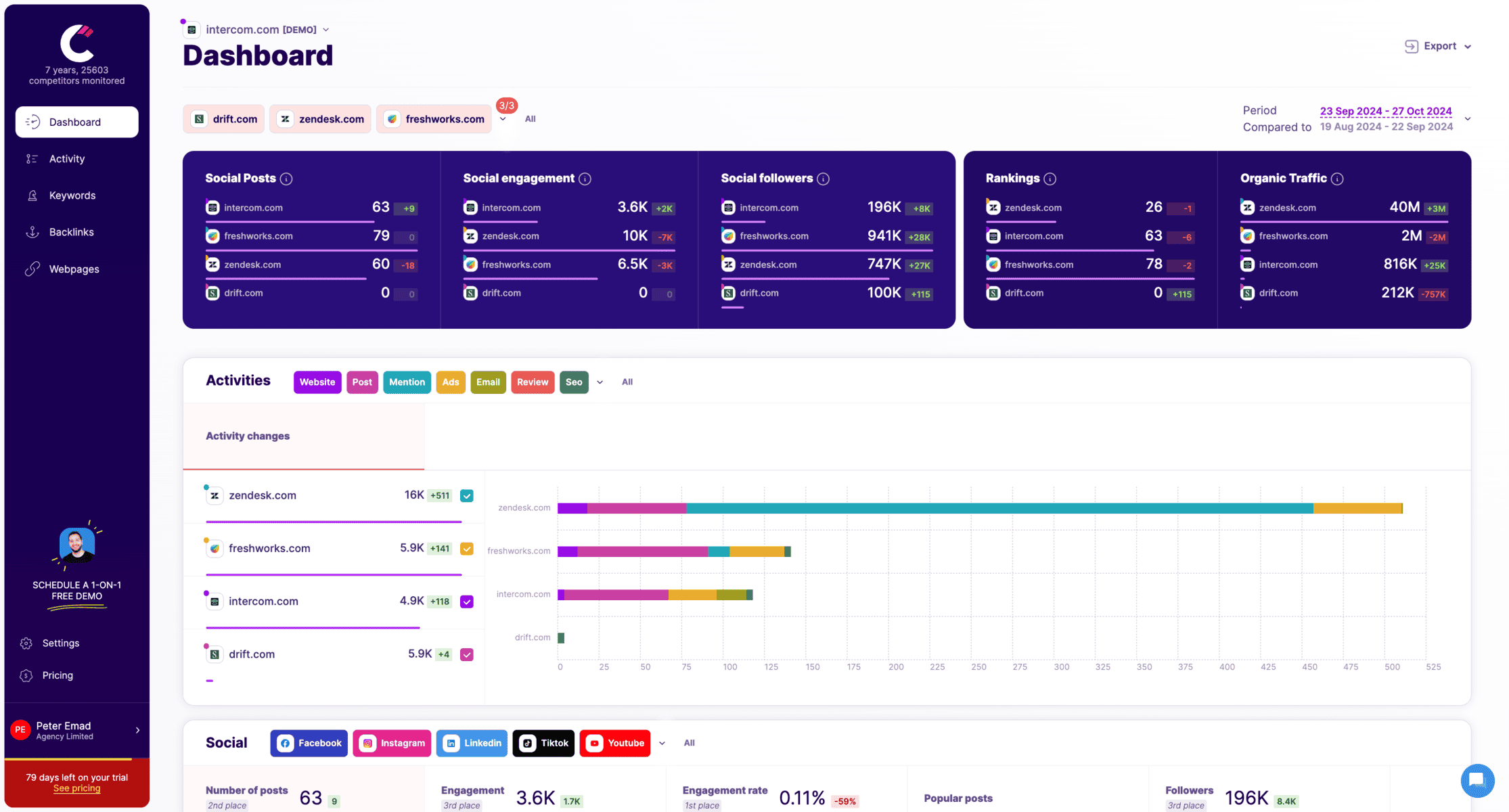
Competitors App is designed for businesses that want to track their competitors’ marketing strategies, content performance, and digital activities. It provides insights into competitors’ SEO, ads, content marketing, and social engagement, helping businesses refine their own strategies.
Key Features:
- Tracks competitor website changes, ad campaigns, and content updates.
- Monitors keyword rankings and SEO trends over time.
- Provides alerts on competitor social media activity and engagement.
- Delivers competitive intelligence reports for benchmarking.
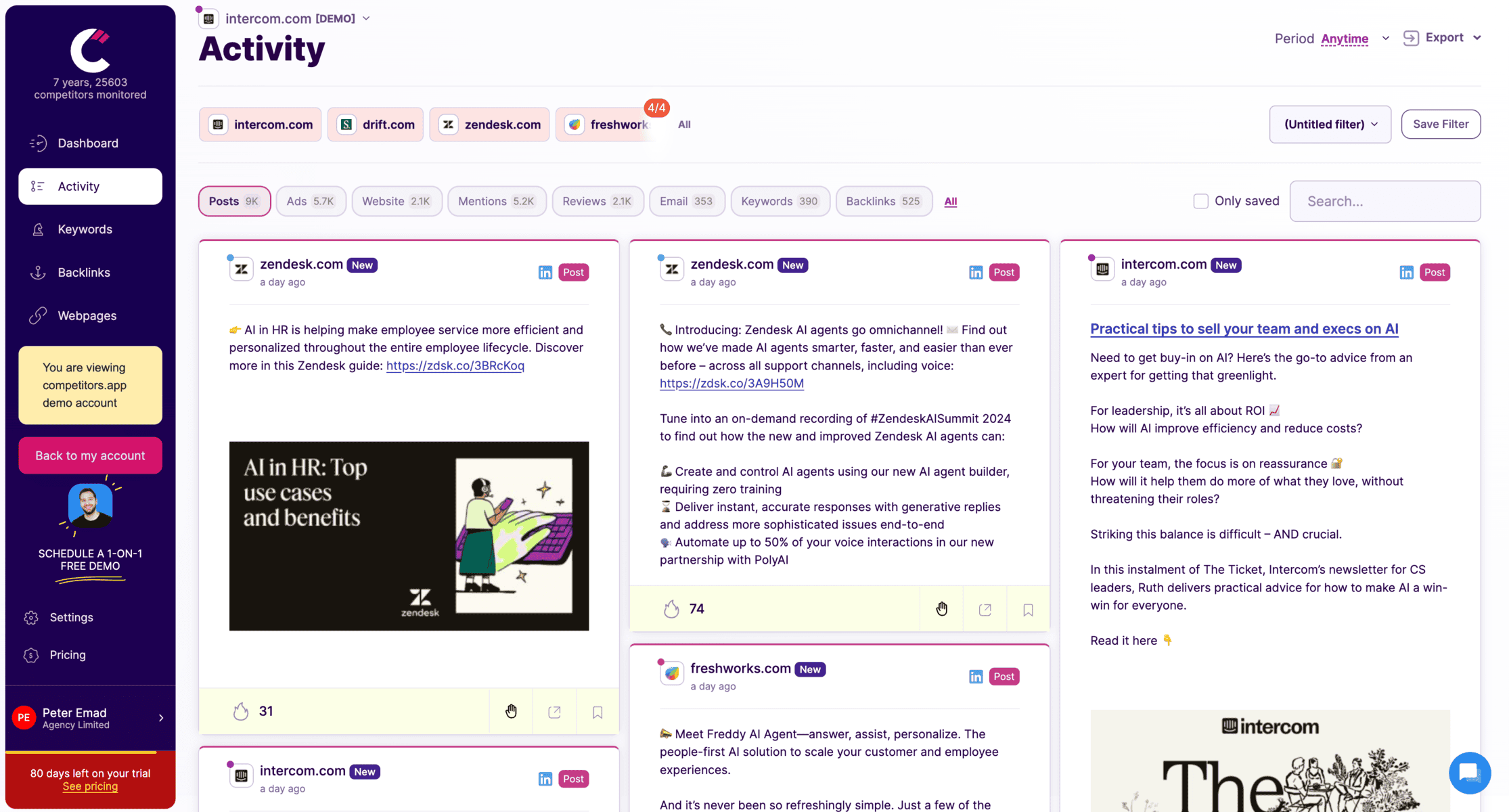
Tracks competitor social media updates across LinkedIn, Facebook, Twitter, and more.
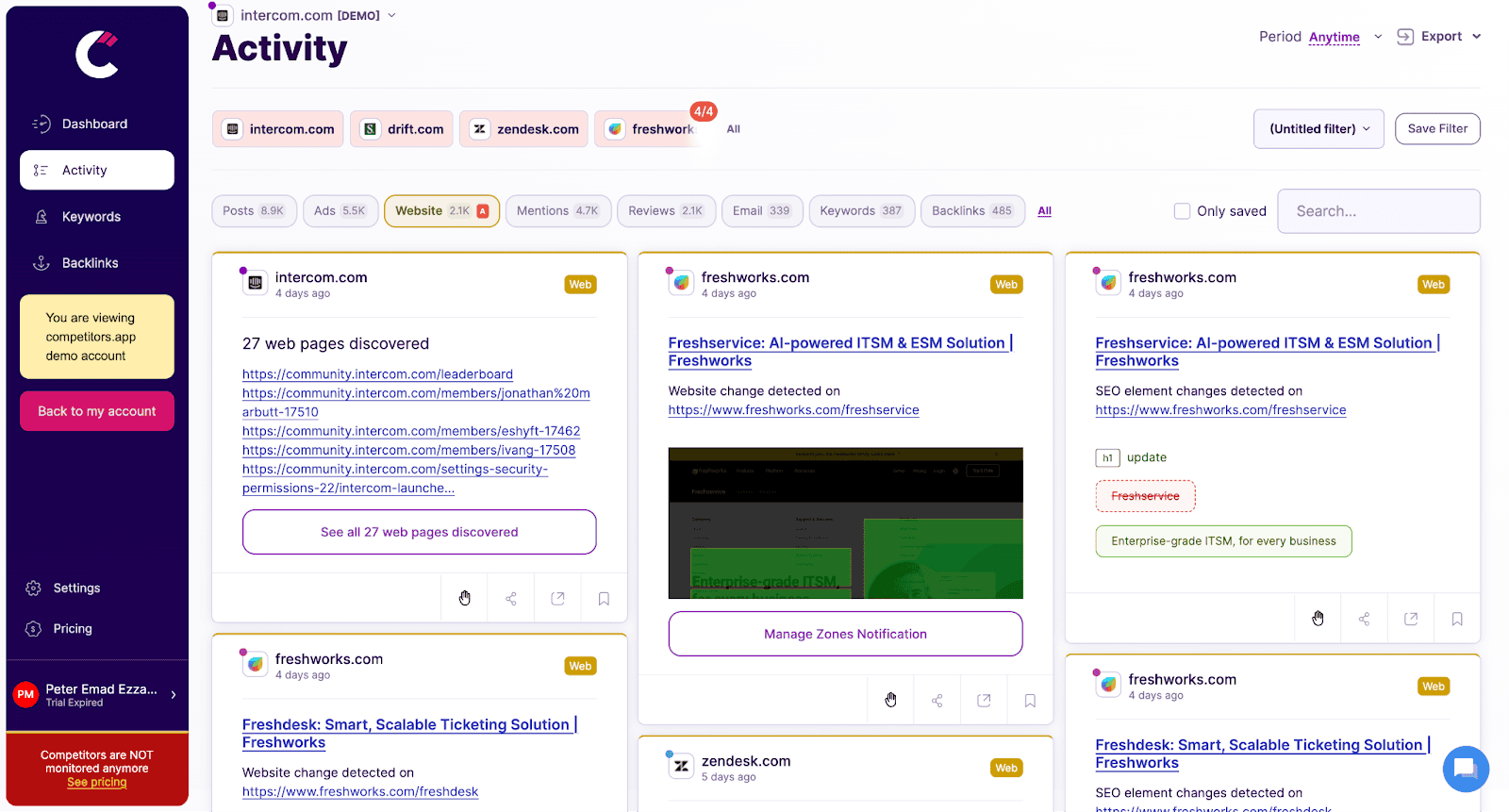
Monitors changes on competitors’ websites, such as product updates, pricing adjustments, and new messaging, providing instant alerts to help sales teams respond promptly.
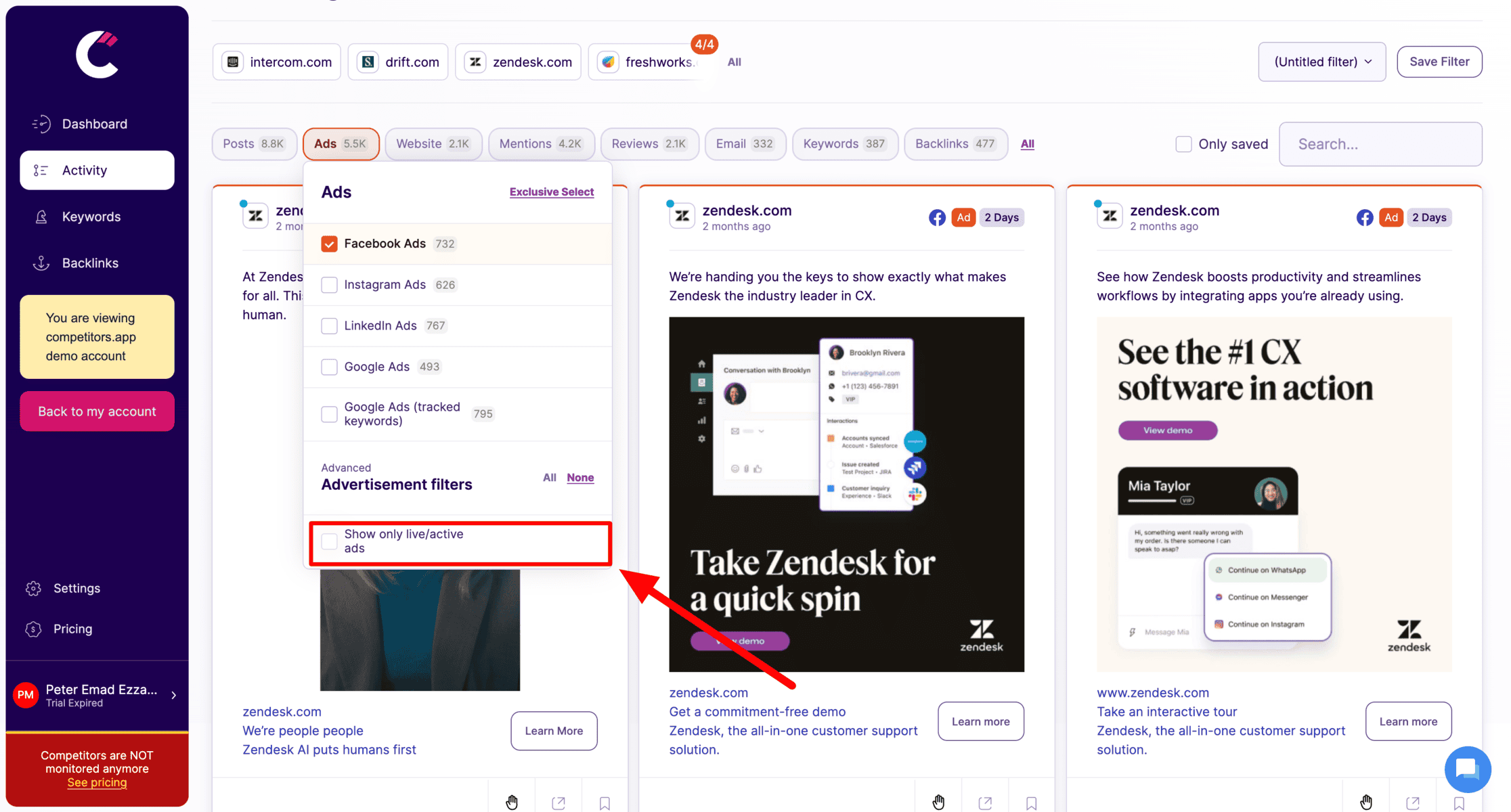
Tracks digital ad campaigns across platforms like Google Ads, Facebook, LinkedIn, and Instagram. It provides details on ad creatives, spending, and performance metrics, helping teams analyze successful ad strategies.

Analyzes competitors’ keyword strategies, organic rankings, and backlinks, allowing teams to refine their own SEO tactics and boost search visibility.

Tracks competitors’ email campaigns, including content, frequency, and engagement metrics, helping sales teams understand email tactics that drive engagement and conversions.
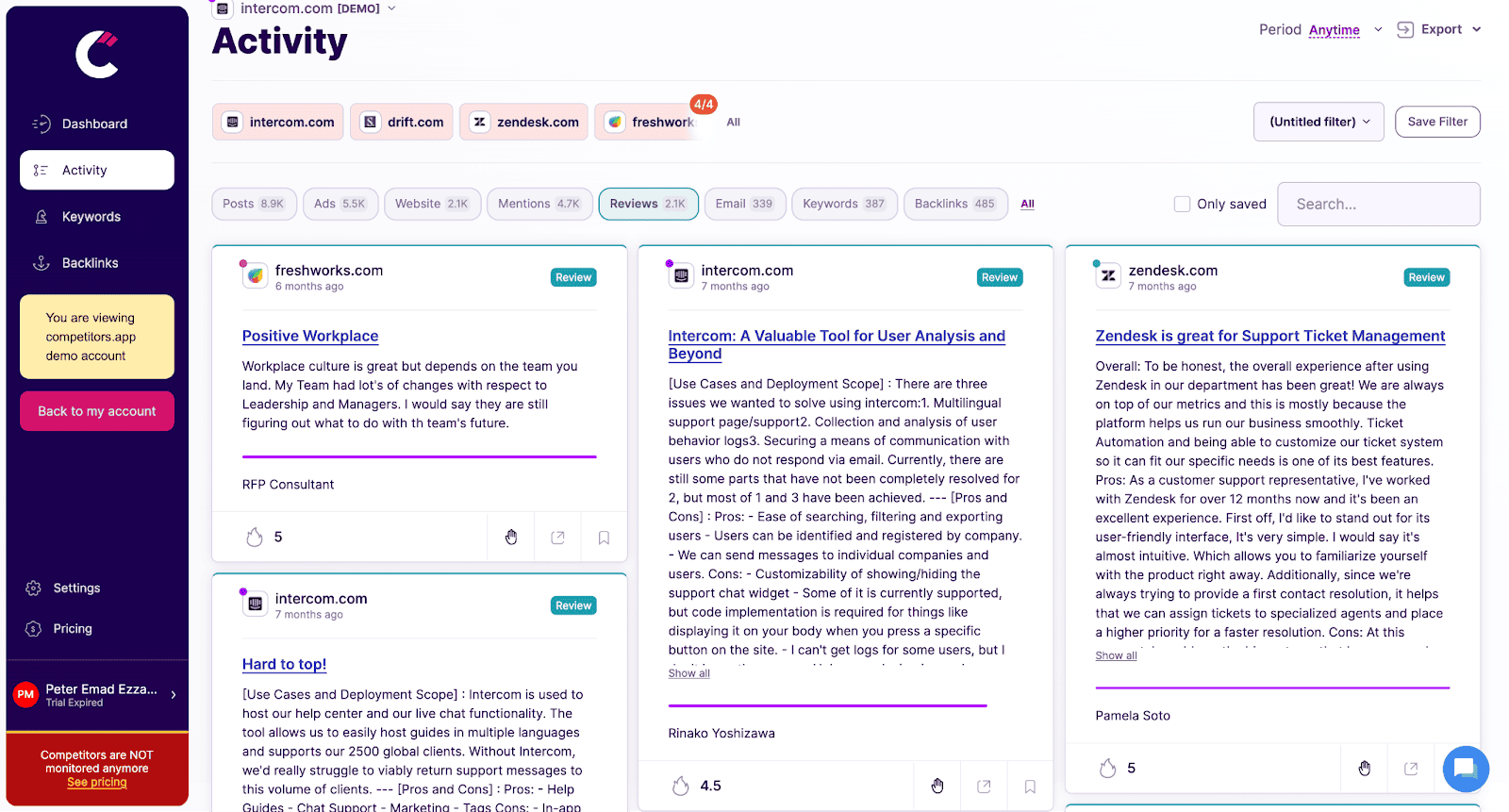
Analyzes customer reviews and ratings for competitors, providing insights into customer feedback, pain points, and product strengths, helping teams craft better sales pitches.
Using LinkedIn for Social Business Intelligence
LinkedIn is one of the most valuable platforms for gathering social business intelligence, especially for B2B insights, competitor analysis, and monitoring industry trends. From tracking company activity to analyzing employee engagement, LinkedIn offers a range of tools that businesses can use to stay ahead of the competition.
Here’s how to leverage LinkedIn for social business intelligence:
Steps to Gathering Social Business Intelligence on LinkedIn
To effectively gather social business intelligence on LinkedIn, businesses should take a strategic approach to monitoring activity across company pages, industry groups, and competitor profiles:
-
Company Page Monitoring:
Regularly monitor your competitors’ LinkedIn pages to track updates on products, services, and company culture. By doing this, businesses can gain insights into the types of content competitors post and how they engage with their audience. This also provides an opportunity to identify gaps in the competitor’s strategy that your business can capitalize on. -
LinkedIn Groups and Discussions:
Participating in LinkedIn groups relevant to your industry or monitoring active discussions can help uncover emerging trends, customer concerns, or gaps in the market. It’s a valuable source of unfiltered feedback and a great way to understand what matters most to your target audience. -
Employee Insights:
Analyzing the social activity of competitors’ employees can offer a unique perspective on their company culture and internal priorities. Employee posts and interactions may provide hints about upcoming product launches, company changes, or shifts in strategy. Monitoring these can help businesses stay informed and adjust their approach accordingly.
Analyzing Competitor Pages and Engagement
LinkedIn is a powerful tool for competitor analysis. By observing the content and engagement strategies of competitors, businesses can refine their own approach:
-
Content Strategy:
Keep track of the types of content your competitors are posting—whether it’s industry insights, product announcements, or customer success stories. Monitoring which posts generate the most engagement can inform your content strategy and highlight areas where you can differentiate your brand. -
Audience Engagement:
Pay close attention to how competitors interact with their audience. Are they responding to comments? How is their community engaging with their content? These interactions can offer insights into the sentiment and needs of their customer base, helping you fine-tune your messaging and engagement tactics.
Leveraging LinkedIn Analytics and Employee Advocacy
LinkedIn offers robust analytics and tools to assess performance, including how employees engage with company content:
-
LinkedIn Analytics:
LinkedIn’s analytics tools provide businesses with data on their company page’s performance, including engagement metrics, audience demographics, and follower growth. Analyzing these insights allows businesses to optimize their content strategy, improve engagement, and measure the impact of social media efforts. -
Employee Advocacy:
Employee advocacy on LinkedIn can greatly amplify brand reach. By encouraging employees to share and engage with company content, businesses can build a more authentic presence. Tracking employee engagement with company posts helps businesses understand how well their brand is being represented across social networks and how effective the advocacy program is.
Key Metrics in Social Media Business Intelligence

Tracking the right metrics is essential for understanding the effectiveness of your social media strategy and gaining valuable insights from social business intelligence.
By focusing on the most relevant KPIs (Key Performance Indicators), businesses can measure the success of their campaigns and identify areas for improvement.
Below are some of the key metrics to track:
Engagement and Sentiment Metrics
Engagement metrics are among the most important indicators of how well your audience is interacting with your content. These include:
Likes, Comments, and Shares:
The number of likes, comments, and shares your posts receive provides a clear indication of how engaging your content is. Higher engagement rates mean your content resonates with your audience. By tracking these metrics, businesses can identify which types of posts generate the most interaction and adjust their content strategy accordingly.Sentiment Analysis:
Measuring sentiment helps businesses gauge the overall mood of their audience, whether positive, negative, or neutral. Social business intelligence tools that track sentiment provide an understanding of how your brand is being perceived across platforms. This can be especially useful in understanding customer reactions to campaigns, product launches, or even PR crises.
Reach, Impressions, and Follower Growth
These metrics help businesses track how far their content is spreading and how their social media presence is growing:
Reach:
Reach measures how many unique people have seen your content. This metric is important for understanding the potential audience size for your posts and determining how far your content is spreading within your target market.Impressions:
Impressions show how many times your content has been viewed. While reach tells you how many individuals saw your content, impressions tell you how often they’ve seen it. This helps in assessing the visibility of your posts and the frequency at which your audience is exposed to your message.Follower Growth:
Follower growth is a key metric for assessing how well your social media presence is expanding. A steady increase in followers indicates that your content resonates with your audience and that your brand is gaining traction within your niche. Tracking this over time can help businesses identify trends and determine the effectiveness of their social media strategy.
Conversion Metrics and Campaign Effectiveness
Tracking conversions is essential for understanding the impact of your social media campaigns on actual business outcomes. Key conversion metrics include:
Click-Through Rate (CTR):
The CTR measures how many people clicked on a link within your post, ad, or campaign. A higher CTR means that your content or ad was compelling enough for users to take action. It’s a key indicator of how well your content drives traffic to your website or landing page.Lead Generation:
Social media can be an effective tool for generating leads, especially when you use lead capture forms or direct calls to action. Monitoring how many leads your social campaigns generate helps evaluate their effectiveness in driving business opportunities.Sales Conversions:
Ultimately, the success of a social media campaign is often measured by how many conversions (purchases, sign-ups, etc.) it generates. Tracking sales conversions from social media campaigns allows businesses to determine the ROI of their efforts and optimize their strategies for better results.
The Future of Social Business Intelligence
Social business intelligence is evolving, and I’ve seen firsthand how it’s changing how businesses make decisions.
Here are a few trends I predict will shape the future:
Spotting Micro-Trends and Predictive Analytics
Social listening tools are getting better at spotting micro-trends—small shifts in behavior that can have big impacts. I expect AI will help businesses catch these trends early, giving them an edge in responding before they become mainstream. Predictive analytics will also become more accurate, helping businesses forecast customer behavior and market shifts with greater precision.
Integrating Social Insights into Cross-Departmental Collaboration
I believe social insights will become more integrated across departments, not just marketing. In the future, sales, product development, and customer service teams will use social data to make quicker, more informed decisions. This cross-departmental approach will streamline business strategies and improve overall responsiveness.
Real-Time Social Monitoring for Smarter Decisions
Real-time monitoring is already a game changer, and it’s only going to get better. I predict businesses will be able to act on social data instantly, adjusting strategies and addressing issues before they escalate, leading to smarter, faster decisions.
FAQs about Social Business Intelligence
What is social media business intelligence?
Social media business intelligence is the practice of using social media data to inform business decisions. It goes beyond simple monitoring and focuses on analyzing engagement, sentiment, and trends across various platforms. By leveraging social media business intelligence, businesses can gain valuable insights into what customers want, track competitor performance, and make data-driven decisions to enhance their marketing strategies.
What are the 5 stages of business intelligence?
The five stages of business intelligence (BI) typically include:
- Data Collection: Gathering data from multiple sources, such as internal databases and social media.
- Data Integration: Combining data from different sources to create a comprehensive dataset.
- Data Analysis: Analyzing the data to identify trends, patterns, and insights.
- Reporting: Presenting the data and insights in an easily understandable format.
- Decision-Making: Using the insights to inform business decisions and strategies.
Social business intelligence fits into these stages, with an added focus on integrating social media data to provide a fuller picture of customer sentiment and market trends.
What is the role of social networks in business intelligence?
Social networks play a crucial role in business intelligence by providing a constant stream of unstructured data. By analyzing social media conversations, businesses can gain insights into customer preferences, emerging trends, and even competitor activities. Social networks offer real-time feedback, allowing businesses to make adjustments to their strategies on the fly. This makes social networks an indispensable tool for modern business intelligence, helping businesses stay responsive and relevant in a rapidly changing market.

